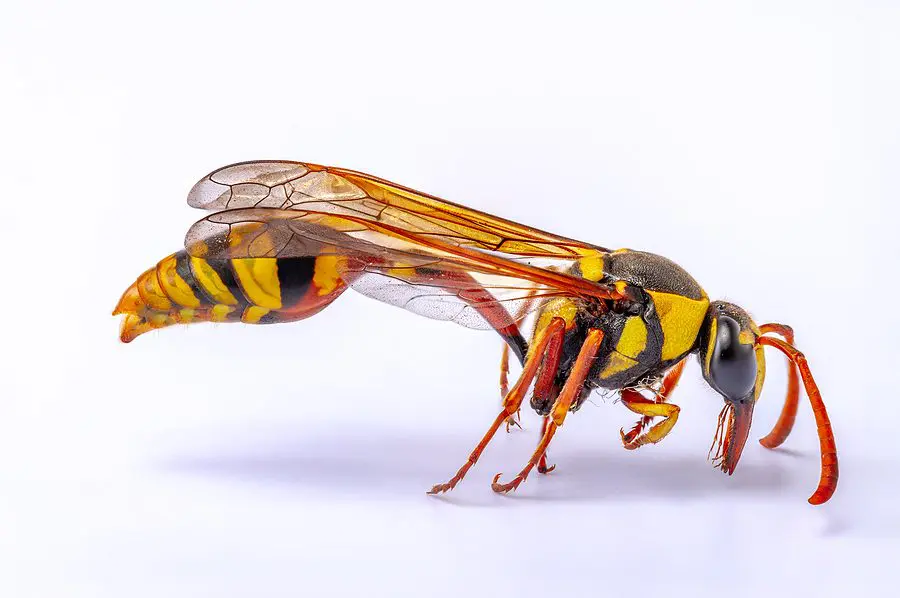Bees and Wasps Identification Methods Everyone Should Know

When you are dealing with a pest problem like bees or wasps, one of the very first things you should do is to identify the type of insects you have at home. Then you can pick the most appropriate method to get rid of them. When it comes to identification of bugs, we often encounter challenges when differentiating bees from wasps. Continue to read and we will share some tips on how you can do it.
How to Spot a Wasp from a Bee
Wasps and bees may first seem to be the same, particularly because they both have distinctive black and yellow stripes. But if you look closely, you’ll see distinctions.
Appearance
Wasps have a more slender, smoother look than bees, which is one of the most obvious contrasts between the two.
Bees often have a deeper yellow tone and a more obvious contrast between their stripes. Their colour may also vary somewhat.
Wasps have long, thin wings that are situated closer to their bodies, but the wings of bees are longer and more rounded.
Habitats
The way bees and wasps build their houses is another significant distinction between the two insects. Typically, bees are renowned for creating elaborate wax hives. These colonies are often seen in hollow tree limbs or even in fissures.
Contrarily, the majority of wasps construct their nests by dangling them from tree branches, eaves, and overhangs. These nests are often constructed of a paper-like substance that wasps produce by chewing plant or wood fibers.
Behaviors
Even though bees and wasps have a similar life cycle, bees are herbivores that mostly on pollen and nectar.
A little quantity of nectar is placed adjacent to each egg cell when the queen bee lays eggs in the hive’s comb in order to provide sustenance for the developing hatchlings. A queen bee leads the colony and lays the eggs, while worker bees take care of the young and go hunting for food. Bees have a hierarchy inside their colonies.
Wasps, on the other hand, often eat other insects, spiders, caterpillars, or grubs since they are carnivorous. Some wasp species also consume fruit, sap, and nectar, although animal prey makes up the majority of their diet. In their normal hunting behavior, adult wasps capture and paralyze their victim before bringing it back to the nest to feed their young.
Different types of bees
Honeybees
Amazing insects called honeybees play a crucial part in our ecology. These bees consume the nectar and pollen of flowers and plants, as implied by their name, which they gather and carry back to their colonies. The nectar and pollen are regurgitated by the bees, and after being broken down by enzymes and evaporated, they become honey. The resultant honey is kept by honeybees within their hives, where they use it as a source of fuel and food during times of shortage.
Bumblebees
Although bumblebees and honeybees are similar in many aspects, bumblebees are usually bigger and have shorter wings. Additionally, bumblebees have distinctive coloring that varies across species but often features vivid yellows, oranges, and blacks. Although they don’t generate as much honey as honeybees do, they do use this nectar to make honey.
Carpenter bees
Carpenter bees are a rare species that are widely recognized for their propensity to demolish wood. Although they resemble bumblebees, their glossy abdomens are the most obvious distinction. To deposit their eggs, these bees have a peculiar behavior in which they bore holes in unfinished wood. These holes may be up to half an inch in diameter and are typically completely round. These cracks might compromise the stability of timber buildings, posing a risk to public safety.
Mason bees
Mason bees, commonly referred to as leafcutter bees, are distinguished by their unique colour, which ranges from blue and black to the more typical yellow and black. Mason bees are solitary and create their nests inside of pre-existing cavities or holes in trees and other outdoor areas, in contrast to other bees that establish big hives or colonies. They build these nests, deposit their eggs within, and then cover them with mud or other materials to provide a secure haven for their young.
Sweat bees
Sweat bees are a particular kind of bee that are distinguished by their intense metallic green or metallic black coloration. Sweat bees are more streamlined and thinner than honeybees and bumblebees. Because of their ability to travel rapidly and readily through their surroundings, they are very effective pollinators. Human perspiration contains salt, which attracts sweat bees, who often descend on individuals in an effort to gather it. While some individuals may find this annoying, it’s crucial to keep in mind that sweat bees are not aggressive and are unlikely to sting unless provoked.
Different types of wasps
Wasps
Wasps are readily distinguished from bees by their rounder and plumper bodies thanks to their sleek, streamlined bodies. Wasps are renowned for their predatory activity, in contrast to bees, who mostly concentrate on gathering pollen and nectar for their colonies. They consume other insects by hunting and feeding, which may aid in reducing pest populations that harm crops and other plants.
It’s crucial to remember, however, that wasps may be far more aggressive than bees and can attack repeatedly. Because of this, they may pose a serious threat to people, particularly those who may be allergic to their venom.
Hornets
Due to their huge size and distinctive black-and-white or brown-and-yellow striped pattern, hornets are gregarious wasps that are easy to identify. The European hornet has an abdomen with stripes and reddish-brown wings that are roughly an inch long. When their nests are disturbed, hornets, which are more aggressive than other wasps, may be harmful. They have a potent sting that may inflict discomfort, edema, and in rare instances, even serious allergic responses.
Yellowjackets
Yellowjackets are a widespread species of wasp that are readily identified by their unique black and yellow wasp stripes. They frequently fly in swarms and are smaller—about half an inch—making them easier to see. They are known to be quite aggressive and can rapidly sting any perceived danger numerous times, which in humans may result in severe pain and edema. A yellowjacket wasp nest, which may hold thousands of wasps, is often built underground or in a protected location like a hollow tree.
Are bees or wasps a problem in your house or place of business? Keep these pests from endangering your security and tranquility. Feel free to get in touch with a professional pest control company today. Then you can get much-needed assistance to overcome the problems that they create.
